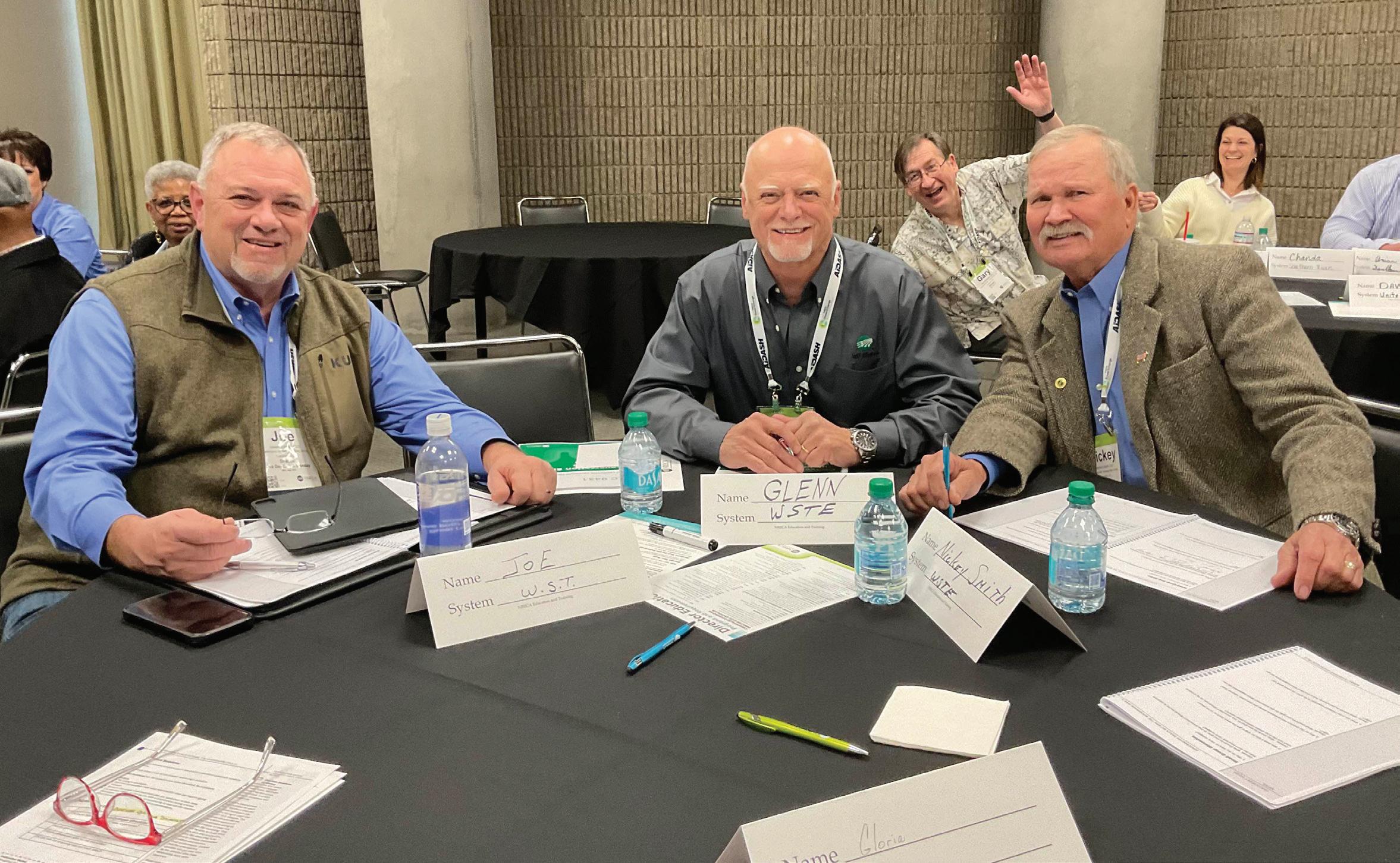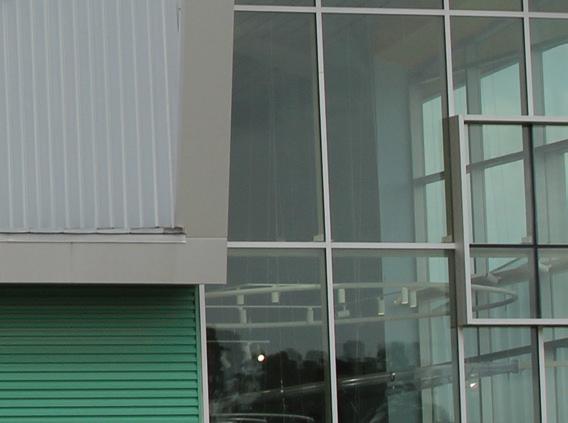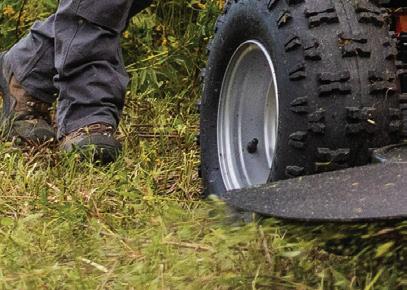Country Louisiana





































Perched in a bucket truck repairing power lines along a busy road, lineworkers have good reason to be concerned about their safety. However, most aren’t apprehensive about falling or working with high-voltage lines. Their biggest worry is the most unpredictable—distracted drivers.
The National Safety Council reports that 891 people were killed and 37,701 were injured in work zone crashes during 2022, in the most recent statistics available. Most crashes occurred at well-marked construction sites. Electric co-op crews can face even greater danger, as they work alone on remote roads, often in heavy rain or weather conditions that reduce visibility.
This danger led every state to adopt “move-over laws” requiring drivers to slow down and switch lanes whenever possible to protect emergency vehicles. The goal is to provide a safety buffer and minimize the potential for accidents. Drivers caught violating the law can face penalties, including significant fines.
Unfortunately, the Journal of Road Safety reports that only 14 states’ moveover laws protect construction trucks and utility vehicles. That means drivers in those states are under no legal obligation to give lineworkers that added margin of safety.
Compounding this issue is the dramatic
increase in distracted driving. The National Transportation Highway Safety Administration reports that as many as 1,000 Americans are injured each day because of activities that take drivers’ attention away from the road. The most common is reading and responding to text messages. If a driver traveling at 55 mph glances at the phone for five seconds, the car travels the length of a football field before the driver’s attention returns to the road.
The design of today’s vehicles contributes to distractions. Many vehicles have complex controls for entertainment and climate that demand the driver look away from the road to make adjustments.
Geography can also be a factor. Co-ops serving rural and remote areas often have power lines along twisty and hilly roads. Locals accustomed to driving those roads at fairly high speeds may be startled and have little time to react when they encounter a work crew past a hill or around a curve.
Besides the potential for lineworker injuries, accidents can also damage or destroy expensive service vehicles, reducing a co-op’s ability to respond to outages and other problems. Power poles and other infrastructure may also suffer severe damage.
Additionally, tasks performed by lineworkers, such as reconnecting
Staff
COMMUNICATIONS COORDINATOR Conley Bourgeois
MEMBER ENGAGEMENT COORDINATOR Rhianna Garon
ACCOUNTING MANAGER Beth Fraser
CREDIT UNION REPRESENTATIVE Jody Overhultz
Board of Directors
President Michael Heinen
Vice President Roger Dale DeHart
Secretary/Treasurer Richard Sitman



ALEC Members
BEAUREGARD ELECTRIC COOPERATIVE INC.
Mike Viator
CLAIBORNE ELECTRIC COOPERATIVE INC.
Mike Marcotte Lane Davidson DEMCO
Daniel Berthelot Richard “Dickie” Sitman
JEFF DAVIS ELECTRIC COOPERATIVE INC.
Michael Heinen Byron Hardee
SOUTH LOUISIANA ELECTRIC COOP ASSOCIATION
Trevor Benoit Roger Dale DeHart
WASHINGTONST. TAMMANY ELECTRIC COOP INC.
Joe Jarrell Dennis Glass
Associate Member

high-voltage power lines, are inherently dangerous and require their complete attention and focus. When distracted by speeding or noisy vehicles, they’re more likely to make mistakes that can complicate the repair or cause injury.
Co-op employees are not at risk only when their vehicles are parked and repairs are underway. Lineworkers often have to drive slowly along the shoulders of roads to pinpoint broken power lines or failed transformers, especially in darkness or limited-visibility conditions.
Many state transportation agencies have work zone awareness programs. Amplifying those efforts by devoting part of a co-op’s advertising, publicity and social media reminds co-op members and other drivers of the importance of giving lineworkers a wide berth.
Co-ops are exploring ways to modify bucket trucks and other service vehicles to increase their visibility. Bright colors and additional lighting, such as flashing strobe lights and lighted detour arrows, can attract attention from a distance. Reflective “work zone ahead” signs can also alert drivers to be ready for an unusual situation. Sometimes, just a little extra attention is all that’s needed to prevent a serious accident.






906 N. Lake Arthur Ave.
P.O. Box 1229
Jennings, LA 70546
337-824-4330 • 337-824-8936 (fax)
Branch office: 815 Highway 27, Bell City, LA 70630 337-598-5700
jdec.org
Michael J. Heinen | CEO
Anya Killmer | Executive Assistant/ Benefits/HR
Eric Gautreaux | Chief Operating Officer
Tara Guinn | Chief Financial Officer
Cade Delcambre | Substations and Metering
Skyler Hebert | Office Manager
Ben Hetzel | Director of Safety/ Member Services
Brennon LaBouve | Engineering Manager
Heath Lemieux | Superintendent
Kain Miller | Superintendent, Jennings
Jonathan Nunez | Superintendent, Hackett
Wendell Thibodeaux | Purchasing Manager/ Warehouse
BOARD OF DIRECTORS
Joseph L. Tupper | President
Thomas Precht III | Vice President
John Berken | Secretary/Treasurer
James Doxey
Byron Hardee
Wilson Dean Landry
Reggie Murphy
Kevin Sonnier
Martin Zaunbrecher
Volume 42, Issue 3
Louisiana Country (USPS 473-180) is published bimonthly by the Association of Louisiana Electric Co-ops Inc., 10725 Airline Highway, Baton Rouge, LA 70816, in partnership with Pioneer Utility Resources.
Annual subscriptions: Members $2.59. Nonmembers $5.
Postmaster: Send form 3579 to 10725 Airline Highway, Baton Rouge, LA 70816.
Periodicals postage paid at Baton Rouge, Louisiana 70821, and additional mailing offices.
Annual Meeting of the Membership Monday, July 14
Registration opens at 8 a.m. Meeting begins at 10 a.m.
Jennings High School, 2310 N. Sherman St., Jennings, LA 70546
Hear reports about your cooperative vote in elections, see informational presentations and have the chance to win prizes. We look forward to seeing you there.
If you’ve never attended an annual meeting, I encourage you to participate. Why? Because input from members like you matters and helps drive the direction of the co-op.
At the annual meeting, we report on current initiatives and discuss the cooperative’s financial health and priorities for the coming years. At this year’s meeting, Jeff Davis Electric Cooperative will update members on the 230-kilovolt transmission line, Federal Emergency Management Agency reimbursement status and general cooperative information. Equally important, this is an opportunity for JDEC to hear from you.
You have the power.

This is also a time to vote for new directors who will represent you and the community’s interests in the co-op. As a JDEC member, you have the power to help shape our community’s energy future.
Electric co-ops are democratically controlled by the members they serve, which means you have a say in who governs your co-op. By voting in the annual director election, you can weigh in on the leaders who make important decisions about the cooperative’s future and our local energy needs.
JDEC’s board of directors consists of community-minded individuals with diverse skill sets. We rely on them to help us make informed decisions regarding long-term priorities and investments. JDEC has nine directors who live in the co-op’s service area. We consider them the eyes and ears of the community because they offer unique perspectives on various local issues.
If you’ve never attended an annual meeting, or if it’s been a while, we hope you’ll stop by. All members attending the event will receive a gift and have an opportunity to win additional prizes.
Your JDEC team will be ready to answer any energy-related questions you may have. We look forward to seeing you at the annual meeting on Monday, July 14, at Jennings High School, at 2310 N. Sherman St., Jennings. Doors open at 8 a.m., and the meeting begins at 10 a.m.
JEFF DAVIS ELECTRIC
Section 1. GENERAL POWERS. The business and affairs of the Cooperative shall be managed by a Board of nine directors, which shall exercise all powers of the Cooperative except such as are by law, the Articles of Incorporation of these Bylaws conferred upon or reserved to the members.
Section 2. QUALIFICATIONS. No person shall be eligible to become or remain a director or to hold any position of trust in the Cooperative who: (a) Is not a member of the cooperative and bona fide domiciliary in the district he is to represent; or (b) Is in any way employed by or financially interested in a competing enterprise or a business selling electric energy or supplies to the Cooperative or a business primarily engaged in selling electrical or plumbing appliances, fixtures or supplies to the members of the Cooperative; (c) Is the incumbent of or candidate for an elective public office in connection with which a salary in excess of $500.00 per annum is paid; and (d) Is an employee of the cooperative within three (3) years from the last date of his or her employment..
Due to hurricanes Rita and Ike or any future natural disaster, a director who becomes domiciled outside of his district shall continue to serve as a director until he resigns, is defeated in an election by a member from his original district or is replaced by an appointment of the Board. Upon establishment of the fact that a director is holding office in violation of any of the foregoing provisions, it shall become incumbent upon the Board of Directors to immediately remove such director from office. Nothing contained in this section shall affect in any manner whatsoever the validity of any action taken at any meeting of the Board of Directors.
Section 3.
(a) NOMINATIONS, ELECTION AND TENURE IN OFFICE. It shall be the duty of the Board of Directors to appoint not less than 60 days or more than 90 days before the date of the meeting of Members at which Directors are to be elected by a committee on nominations consisting of not more than the number of Directors to be elected, which committee members shall be selected one from each of the districts of the area served by the Cooperative from which a director is to be elected at the ensuing meeting. No member of the Board of Directors may serve on such committee. The committee shall prepare and post at the principal office of the Cooperative at least fifty (50) days before the meeting a list of nominations for directors. Any fifteen (15) or more members acting together may make other nominations by petition not less than forty (40) days prior to the meeting, and file petition with the Secretary, and the Secretary shall post such nominations at the same place where the list of nominations made by the committee is posted. The Secretary shall mail with the notice of the meeting or separately, but at least thirty (30) days before the date of the meeting, a statement of the number of directors to be elected and the names and addresses of the candidates. The names shall be arranged by districts and shall specify separately the nominations made by the committee on nominations and also the nominations made by petition, if any. Notwithstanding anything contained in this section, failure to comply with any of the provisions of this section shall not affect in any manner whatsoever the validity of any election of directors.
(b) ELECTION AND TENURE. In the year 1979, nine board members shall be elected to office. Each board member shall represent one of the nine districts, and shall be elected in conformance with procedures as hereinafter described except that the term of office for each will be as follows: The board members representing Districts 1, 4 and 7 shall each be elected to serve until the annual meeting to be held in the year 1980 or until their successors shall have been elected and shall have qualified. The board members representing Districts 2, 5 and 8 shall be elected to serve until the annual meeting to be held in the year 1981 or until their successors shall have been elected and shall have qualified. The board members representing Districts 3, 6 and 9 shall be elected to serve until the annual meeting to be held in the year 1982 or until their successors shall have been elected and shall have qualified. Beginning in the year 1980, three board members shall each be elected for a three-year term to fill vacancies caused by expiration of the incumbents’ terms of office.
To win a prize, business accounts must be represented by an authorized officer of the firm or organization.
The bylaw regarding firms and associations reads: “A duly authorized officer of any firm, corporation, partnership, association or political body may, upon proper proof of his authority, claim a prize for his firm or group.”
Before the meeting, firms must furnish an authorization to Jeff Davis Electric Cooperative Inc. These rules are consistent with the coop’s bylaws.
To claim a prize, you must be at least 18, a member or spouse of a member and furnish proof of membership by the registration card provided to you. Only one card for each member is eligible, even though a member may have several meters.
You cannot claim a prize for any account but your own.
In accordance with the bylaws of Jeff Davis Electric Cooperative Inc., the Nominating Committee appointed by the board of directors will meet at 9 a.m. May 6, 2025, the cooperative office in Jennings, Louisiana, 906 N. Lake Arthur Ave.
Board members running for reelection this year are:
Joseph L. Tupper Jr., District 1
Byron Hardee, District 4
Herman Thomas Precht III, District 7



Altec, Altec Truck, Altec Capital, Altec Sentry, AWP, JJ Kane, Linetec, Osmose and Tempest will award nine $500 scholarships for fall 2025 at the Association of Louisiana Electric Cooperatives Annual Meeting in July.
The following rules apply:
• Applicant must be the dependent of an ALEC member cooperative, including Beauregard Electric, Claiborne Electric, DEMCO, Jeff Davis Electric, Panola-Harrison Electric, South Louisiana Electric or WashingtonSt. Tammany Electric.
• Applicant must be a 2025 high school graduate.
• Applicant must provide verification of a minimum 2.0 GPA before scholarship is awarded.
• This is a one-time award.
• The award can be used for any college or university.
Application and current transcript must be postmarked by June 30, 2025. Altec is not responsible for mail delivery.
Mail to Ed Amedee, 1443 City Place, Gonzales, LA 70737.
Name of applicant: ______________________________________
Name of parent or guardian: ______________________________
Member co-op: _________________________________________
Address:
Phone number: ________________________________________
Name of high school: ____________________________________






Make a $1 donation to the Cooperative Youth Leadership Fund to enter a drawing for a new portable Blackstone grill.
Tickets are available at your electric cooperative.
The prize drawing is held in July at the Association of Louisiana Electric Cooperatives Annual Meeting banquet in Baton Rouge.
You do not need to be present to win. The winner is contacted by phone.


Did you know there are several ways to save energy during spring months?
Read the energy-saving tips below to learn more, then find the bolded words in the puzzle below.
• Use LED lights around your home. LEDs use 75% less energy than traditional incandescent light bulbs.
• Plant shade trees around your home to block unwanted heat from the sun.
• Unplug devices and electronics that consume energy when they’re not in use, like phone chargers.
• Seal air leaks around exterior doors and windows to save energy and keep your home comfortable.
• Ceiling fans cool people, not rooms. To save energy, turn them off when you leave the room.





































Story and photos by John N. Felsher







Capped by Lake Salvador to the north and Barataria Bay to the south, the Barataria Estuary offers anglers some of the best inshore saltwater fishing action in North America in a beautiful wilderness setting close to Louisiana’s largest city.
“We’re about 19 miles south of New Orleans,” says Theophile Bourgeois IV, of Bourgeois Fishing Charters in the town of Barataria. “We can see New Orleans across the marshes when we’re fishing. Just outside that metropolitan area, we have such a lush natural environment with so many fish, bird and animal species.”



As the son and namesake of a late, and legendary, fishing guide, Theophile grew up fishing these rich waters. Between Lake Salvador and Barataria Bay, anglers can fish unlimited ponds, bayous and other waters for various species. These marshes create ideal nursery grounds for many species.
Redfish
At times, anglers spot huge schools of bull redfish ravaging mullets and other baitfish in Lake Salvador, Barataria Bay and other places. In the marsh ponds, the spot-tailed marauders habitually get in water so shallow that their coppery backs protrude above the surface.


“All the ponds and bayous north of Barataria Bay hold good redfish numbers,” Theophile says. “Some better places include the Bayou Dupont area, Airplane Bay, Round Lake and Lake Laurier. We look for good, clean moving water and baitfish. On a falling tide, I like to fish where a (trench) drains the marshy ponds. I also like to work the grassy points.”
Anglers can catch redfish many ways. Many dangle live shrimp or soft-plastic shrimp lures under popping corks. Spoons, jigheads tipped with plastic trailers and spinnerbaits also work. When redfish turn more aggressive, nothing excites anglers like big redfish erupting on a topwater bait.
“Sometimes we spank the redfish on gold spoons,” Theophile says. “Silver or bronze colors also work. I always keep a topwater bait tied to one line. There’s nothing better than watching a big redfish explode on a topwater bait.”




More known for producing great numbers than giant speckled trout, the Barataria area does hold some big fish. Most trout weigh 1 to 3 pounds, but anglers occasionally catch bigger ones. Larger trout generally come from bigger bays and lakes closer to the gulf.
Although anglers can catch speckled trout, redfish and flounder in many places on the same baits, specks typically prefer deeper waters. Look for them in the passes, larger lakes and deeper bayous—particularly where two streams intersect or a bayou connects with a lake. Trout hunt shrimp and baitfish in open waters, so lures that imitate natural prey work best.

“A popping cork with soft plastics is hard to beat for catching trout at any time of year,” says Mike Helmer with Capt. Phil Robichaux’s Fishing Charters in Lafitte. “We also fish soft plastics on the bottom.”
Few anglers intentionally fish for flounder, but nobody wants to throw back one of the tastiest fish anywhere. Twice each year, flounder migrate into and out of the estuaries, but some stay in inshore waters all year long. Flounder generally leave the marshes, bays and estuaries in late October or November when water temperatures chill. After spawning and spending the winter in the gulf, flatties head inshore in March or April.

congregate in deeper water with shell or hard bottoms.”
Although challenging to clean, sheepshead taste delicious. Sheepshead eat barnacles, crabs, shrimp and other crustaceans. They stay near hard structures with barnacles, such as pilings and reefs. Sheepshead put up a tremendous fight. They hunker down and dare anglers to pull them to the surface.
“At the right time, we can catch as many sheepshead as we as feel like fighting in some of the deeper channels lined with rocks,” Mike says. “They are a lot of fun to catch.”

Flounder normally hit natural baits, like minnows or shrimp, but the surprisingly agile and aggressive fish do strike soft plastics, spoons, spinnerbaits and other lures. Drifting a live shrimp, minnow or shrimp imitation under a popping cork along a weedy shoreline works effectively. Another technique is to hook a live minnow to a jighead and drag it along the bottom. The squirming minnow attracts a flounder’s attention.
Besides redfish, speckled trout and flounder, Barataria anglers might also catch sheepshead, black drum, white trout and other species. On any given day, anglers may land seven or more different fish species in the same general area on the same baits, particularly when fishing with live or dead shrimp.


Whether loading a boat with speckled trout or battling monster drum and redfish, anglers can usually find something biting most days in this fertile delta wetland wilderness ecosystem surrounded by abundant wildlife.
To book a trip, call Bourgeois Fishing Charters at 504-341-5614 or visit www.neworleansfishing.com. For Capt. Phil Robichaux’s Fishing Charters, call 504-689-2006 or visit fishwithphil.com. For area information, contact Visit Jefferson Parish. Call 504-203-6740 or 877-572-7474. Online, see www.visitjeffersonparish.com.

“We catch drum when fishing for redfish with shrimp,” Theophile says. “With shrimp, we catch a lot of different species.”
Black drum can grow huge and put up a tremendous fight. The biggest sport fish in Louisiana inland waters, a black drum can exceed 70 pounds, providing outstanding action on light tackle. Smaller drum make excellent eating.
A black drum might hit an occasional soft-plastic lure but generally prefer fresh meat such as shrimp or baitfish. However, nothing appeals to a drum or a big redfish more than a crab. Some people use small live crabs hooked through the back near the rounded “swimmer” fins. For larger drum and redfish, remove the top shell of a crab and break it into two halves. The succulent juices oozing from a half crab drive drum and redfish wild.
“We catch some big black drum in the deeper holes on cracked crabs with Carolina rigs,” Mike says. “They usually




By Cheré Coen
Summertime isn’t so easy when tiny feet are running around looking for fun things to do. Don’t worry; Louisiana offers plenty of day-trip destinations and attractions. Many are free.









A local National Park Service site, Jean Lafitte National Historical Park and Preserve has five Louisiana units: Lafayette, Eunice, Thibodaux, the Chalmette Battlefield and the French Quarter Visitor Center.
Hours vary—Eunice is only open Thursdays through Saturdays, for instance—but entrance to all parks is free. In addition to learning about the people who settled South Louisiana, visitors may enjoy special events, such as boat rides at the Wetlands Acadian Cultural Center in Thibodaux.


Louisiana is home to several children’s museums, including the Children’s Museum of Acadiana in downtown Lafayette and the Louisiana Children’s Museum in New Orleans’ City Park.
A few years ago, Baton Rouge opened the Knock Knock Children’s Museum,







a 26,000-square-foot facility inside the Baton Rouge Recreation and Environmental Commission’s City-Brooks Community Park. The museum features 18 learning stations, including a two-story climbing structure, interactive play areas and education programming.
In Shreveport, Sci-Port Discovery Center combines science and entertainment in its massive museum. It includes a planetarium, an IMAX Dome Theater, more than 200 hands-on exhibits and special events.
New this year is the Children’s Museum of Southwest Louisiana at Port Wonder, on North Lakeshore Drive on the Lake Charles lakefront, right off Interstate 10. Four galleries filled with interactive exhibits keep children occupied. The museum hosts special events throughout the year, and party rooms are available.
Next door is the Louisiana Department of Wildlife and Fisheries’ new Nature and Science Center, with freshwater and saltwater aquariums.
Visit a Park
There are 21 state parks within Louisiana. Amenities range from lakefront cabins and a beach at Fontainebleau State Park on Lake Pontchartrain in Mandeville to Civil War history at Port Hudson
near Baton Rouge and ancient Native American mounds at Poverty Point World Heritage Site.
State parks visitors can bathe in the great outdoors at Toledo Bend in the South’s largest manmade lake, stargaze while enjoying the renovated cabins at Sam Houston Jones State Park north of Lake Charles and learn about the state’s unique habitats at the Louisiana State Arboretum.



Many cities offer their own ways to get outdoors. In Baton Rouge, for instance, there are more than 170 parks inside the BREC system. Daily programming includes classes, special events, a state-of-the-art observatory, a zoo and the Blue Bonnet Swamp Nature Center. BREC is one of the few parks and recreation agencies in the country to win multiple national awards for excellence.
One way to beat the heat this summer is by plunging into cool waters. There are many splash pads to choose from, including those at Parc San Souci in Lafayette, Palmetto Island State Park south of Abbeville, the Splash Park in Sulphur and six locations around the Shreveport-Bossier area. Most are open during daylight hours from Memorial Day or earlier until midfall.
If you’re really into water, Blue Bayou Water Park outside Baton Rouge provides H2O in a variety of ways, from heart-racing rides to lazy rivers and wave pools.
Artspace in Shreveport wears many hats. It’s an art exhibition space, for sure—don’t miss the Critical Mass annual invitational exhibition for artists who live in the nine parishes of Northwest Louisiana. But Artspace mostly provides a space for the public to experience art in a variety of ways, from classes and workshops to interactive events.
Look around Louisiana, and it’s easy to see why there are so many canoe and kayak rentals. The state has massive bodies of water,

from the Atchafalaya Basin—the nation’s largest river swamp—to Lake Pontchartrain, where the causeway is the longest continuous span over water in the world. Then, there are bayous and rivers galore.
A few places to rent canoes or kayaks are Pack and Paddle and Wanderlust Rentals in Lafayette, Lake Area Adventures in Lake Charles, Wildwood Resort on Toledo Bend and McGee’s in Henderson. If paddling is too much work, several outfitters rent tubes for a slow float on the Bogue Chitto River north of Lake Pontchartrain.
Go Pickin’
Strawberry picking at Mrs. Heather’s on Highway 43 in Albany runs through May 11. Owner Heather Hughes provides buckets and sets vistors free to pick. She hosts special events as well.
“We have many activities for kids, including a zip line, tunnel slides, a corn box, a jumping pillow, a swing set, a merry-goround, face painting and milking the cows,” Heather says.
Folks enjoying the Creole Nature Trail south of Interstate 10 in the state’s southwest corner sometimes come upon a startling sight— a rare albino bottlenose dolphin with a pink hue. Nicknamed “Pinky,” this rosy-hued dolphin has become so popular there’s even a Facebook page dedicated to sightings. The best place to spot Pinky and other dolphins is along the Calcasieu Ship Channel and surrounding waterways south of Lake Charles.
There’s nothing like a road trip, and Louisiana offers 19 scenic drives for those who don’t want to plan an itinerary.
In the northwest corner, the Boom or Bust National Scenic Byway stretches 136 miles through four parishes to spotlight the area’s history, parks, fields of blooming sunflowers, back-road eats and more.
The Creole Nature Trail All-American Road forms a massive loop from Interstate 10, east of Lake Charles, through prairies, bayous, marshlands, 26 miles of Gulf Coast beaches before returning north to Sulphur. The Southern Swamp Byway winds through Ascension Parish and Ponchatoula, then down toward Lake Pontchartrain and ending at LaPlace and its famous andouille.
For more on Louisiana’s byways, visit explorelouisiana.com/ articles/take-scenic-route-louisianas-byways.
When temps begin to rise, a cool museum visit may be in order. The Beauregard Museum in DeRidder tells the history of the region, with Native American artifacts and items from the sawmill days. It also explains the region’s development with the arrival of trains. The museum is in a former Kansas City Southern passenger train depot, and children love exploring the caboose in the courtyard.
In Crowley, the three-story Crowley Motor Co. & Ford Building— built in 1920—houses several museums under one roof: the Rice Interpretive Center, the History of Crowley, the J.D. Miller Music Recording Studio and the Ford Automotive Museum.

For those who prefer oddities, Abita Mystery House in downtown Abita Springs fills the former gas station, barn and other buildings with a collection of dioramas, arcade games, paintby-number scenes, folk art objects and Darryl the Dogigator, who is half dog and half gator.
Who knew there were dinosaurs outside the Atchafalaya Basin in Henderson? We’re talking dinos of all kinds, including five animatronic beasts. The dozens of dinosaurs of Prehistoric Park that’s adjacent to Camp Margaritaville RV Resort won’t eat you, thank goodness, but they are life-sized replicas.
Stroll through 12 acres to spot these ancient creatures, then enjoy the other attractions, such as fossil digs and gem mining. n

Festivals to Consider Art for Animals Festivals, Baton Rouge Zoo: Through May 3
Gonzales Jambalaya Festival: May 23-25, jambalayafestival.net
Gheens Bon Mangé Festival: June 6-8, gheensbonmange.weebly.com/festival.html
Holly Beach Crab Festival, Cameron: June 13-15, www.visitlakecharles.org/event/holly-beach-crabfestival/46592
St. Landry BBQ Festival, Yambilee Grounds in Opelousas: June 20-22, stlandrybbqfestival.com
Erath Fourth of July Festival: June 30-July 4, erath4.com












































Mower gives you MORE


POWER – to mow through anything with up to 2X more than the competition. MANEUVERABILITY

– thanks to power steering and hydrostatic drive options.


FEATURES
– including easy to use controls and available attachments.

CHOICE and Tow-Behind models available.


– Commercial, Electric, Walk-

















































































Each year, more than 3,800 people die from drowning. Electric shock drowning occurs when an electric current escapes boats, docks and lights near marinas, shocking nearby swimmers.
There are no visible signs of current seeping into water, which makes this a hidden danger
The electric shock paralyzes swimmers, making them unable to swim to safety.
• Never swim near a boat or launching ramp. Residual electrical current could flow into the water from the boat or the marina’s wiring, potentially putting anyone in the water at risk of shock.
•If you feel any tingling sensations while in the water, tell someone and swim back in the direction from which you came. Immediately report it to the dock or marina owner.
• Ensure your boat is properly maintained and consider having it inspected annually. Groundfault and equipment leakage circuit interrupters circuit interrupters should be tested monthly. Conduct leakage testing to determine if electrical current is escaping the vessel.
• Use portable GFCIs or shore power cords (including “Y” adapters) that are “UL- Marine Listed” when using electricity near water
• Regularly have your boat’s electrical system inspected by a certified marine electrician. Ensure it meets your local and state National Electric Code, National Fire Protection Association and American Boat and Yacht Council safety codes.
DO NOT enter the water. You could become a victim, too.


Louisiana cooperatives are mourning the loss of longtime co-op leader and advocate Hayward “Buck” Theriot Sr., 79. A native and resident of Houma, Buck died Feb. 17 of Parkinson’s disease and Lewy body dementia. Best known for his generous spirit and infectious Cajun humor, Buck dedicated his life to serving others through his work and passion for giving.
He is survived by his wife of 30 years, Earline M. Theriot; sons John Theriot (Nicole) and Hayward Theriot Jr. (Paul); daughter, Melissa Davis; stepchildren Bobette Talbot (Mark), Leigh Champagne (James), Marty Domangue (Danae) and Kyle Domangue (Julie); grandchildren Morgan Arceneaux, Skylar Davis and Baely Davis; stepgrandchildren Therese Talbot, Everette Talbot, Kayleigh Gordon, Kandice Bergeron, Kirstie Cryer, Brady Domangue, Bryce Domangue, Olivia Rasberry, Emma Domangue, Kylie Domangue, Gracie Gautreaux, Carlie Christ and Elle Christ; three great-granddaughters and 18 stepgreat-grandchildren, with two soon to be born; and sisters Jan Vice (Cary), Debbie Doiron (Jimmy) and Elaine Monnier (Harold).
Buck was preceded in death by his parents, Oscar and Eula Toups Theriot; grandson Wade Theriot; and son-in-law Todd Davis.
Buck served in the Army National Guard for seven years and five months before joining South Louisiana Electric Cooperative Association in 1964. Throughout the course of his 48-year career, he rose to superintendent at SLECA, retiring in 2012. Despite the long tenure, a single life-altering incident in 1990 sparked his most enduring legacy. After a lineworker friend survived a severe electrical burn, Buck realized lineworkers needed more rigorous safety training. Upon accepting a job as the Louisiana Association of Electrical Cooperatives’ state safety and training director, he wrote a four-year, eight-level training manual that integrated both hands-on instruction and safety. By the time he retired, more than 300 linemen had completed this program.
Buck’s leadership extended beyond Louisiana, as he served as chairman of the Southern Area Instructors Association and later the National Association of Utility Safety and Training



Hayward “Buck” Theriot Sr.
Professionals. He traveled widely to teach these courses, often accompanied by Earline. He broke the ice at each session with a Cajun story—quickly becoming legendary for his humor and ability to make tough, hardworking lineworkers feel at ease.
His kindness and generosity stretched well beyond the classroom. Known to cook jambalaya in large, black iron kettles, Buck often led fundraisers for churches and local causes. Even after the heartbreak of losing his grandson Wade to Type 1 diabetes, he organized cooking events that raised thousands of dollars for the Juvenile Diabetes Research Foundation. Whether he was serving gumbo for 50 people at a holiday gathering or dishing it out for church fundraisers, Buck always did it with a smile and a giving heart.
Louisiana’s cooperative community will remember Buck as a generous spirit and a champion of safety whose Cajun charm, culinary talents and devotion improved countless lives and probably saved a few. He was the kind of man who gave tirelessly and asked for nothing in return. He leaves behind a legacy of mentorship, warmth and dedication that will guide those who knew him, as well as future generations of Louisiana lineworkers.
Electronic and mobile devices, TVs, computers and gaming stations have become ubiquitous fixtures in our homes, particularly those with children. Consumer electronics coupled with the proliferation of smart home appliances, technology and electric vehicles have slowly but steadily changed our homes and lifestyles.
This ever-connected world is the modern environment in which children are growing up. With lifestyles increasingly reliant on technology and in turn, energy consumption, teaching the younger generation to save energy is an important life lesson.
Before parents can teach their children how to save energy, they must first answer the question, “What’s in it for me?”
As most parents can attest, convincing children to care about energy efficiency is a hard sell. Parents need to explain why it’s important to save energy and how it benefits the child—otherwise they do not understand the need to change their habits and are less motivated to do so. In the simplest terms, less money spent on an electric bill can mean more money used for fun activities, which is something children can relate to.
Less tangible, but just as important, using less energy means running your home more efficiently, conserving natural resources and helping the environment.
Because saving energy is an abstract concept for children, be specific about energy efficiency actions and set an example.
We know children learn by observing what their parents do. Even if they don’t say anything, children are processing your actions. When you turn off the lights when leaving a room or unplug the phone charger once the device is fully charged, they notice.
Learning about energy efficiency doesn’t

have to be a boring lecture. Make it fun for greater impact.
For younger children, turn energy efficiency into a treasure hunt to locate all the things in your home that use electricity. Depending on the age of the children, challenge them to count and group the items into categories: electronics, appliances, lights, etc. If age appropriate, have them create a list. Ask which gadgets and appliances could be turned off or unplugged to save power every day.
For older children, show them how to program smart thermostats and appliances. Shop with them for LED lights and discuss Energy Star-rated appliances. Show them the electric bill so they can see the costs, energy use and how their actions impact the bill.
Children can learn a few simple energysaving habits that can last a lifetime:
• Turn off lights, devices, computers and video game consoles when not in use.
• Open blinds and curtains during winter days to let warm sunlight in, and close them during summer days to keep your home cooler.
• If your children are old enough to run the dishwasher or wash their own clothes, teach them to run these appliances only with a full load and during off-peak energy hours.
Offer rewards for agreed-upon milestones. Rewards provide positive reinforcement on energy-saving actions.
The idea is to create a habit of being energy efficient. For parents, this could mean less nagging about turning off the lights.
Teaching your children about saving energy is not only a creative way to spend time with them; it helps your home be more energy efficient and can instill good habits that benefit your child as they make their way into adulthood. n

JEFF DAVIS ELECTRIC


Rustic charm meets practical elegance at Lacassine’s new event venue
By Conley Bourgeois

















In the heart of Lacassine, a new venue is ready to host the community’s special moments. Pierre’s Place, created by Paul Lynn Guidry and his wife, Celena, known locally as the duo behind restaurant Lil Cochon’s Cajun Kitchen, addresses the town’s need for a modern gathering space. After just one year of planning and construction, their vision became a reality, and Pierre’s Place is quickly becoming a preferred destination for weddings, family reunions, school dances and other events.
The venue recently opened its doors with the wedding of Melody and Josh Pickle on March 1. The 5,670-square-foot facility blends rustic charm with practical elegance, featuring an outdoor courtyard suited for ceremonies, private suites for brides and grooms, a spacious ballroom ideal for receptions and corporate gatherings, and a fully equipped kitchen for on-site catering. Additionally, a screened-in barbecue smokehouse offers a unique catering option.
Pierre’s Place provides customizable event packages, including catering from Lil Cochon’s Cajun Kitchen, full bar services, seating arrangements and linens. Specialized packages tailored for school functions are also available, and the venue welcomes outside vendors with appropriate licensing.
Reflecting its commitment to the community, Pierre’s Place will host the Hannah Vincent Music Festival fundraiser on Saturday, Nov. 15. The event will feature six live bands, food and entertainment, with proceeds benefiting local FAA and 4-H student scholarships in memory of Hannah Vincent. Tickets will be available through the venue’s Facebook page or at the door.
Pierre’s Place is currently booking events for 2025 and 2026. To schedule a tour or reserve an event date, contact Paul at 337-802-9459. Follow Pierre’s Place on Facebook for the latest news and updates.














































































































































































































Give your home a safety checkup to stay a step ahead of electrical fires
By David Herder
As the season shifts to summer, it’s the perfect time to prioritize safety, especially electrical safety, in your home.
According to the National Fire Protection Association, electrical failures and malfunctions contributed to 30,000 fires, 430 deaths, 1,070 injures and $1.3 billion in property damage every year between 2015 and 2019.

Give your home an electrical safety checkup to keep it how you like it—safe and free of electrical fire hazards.













































Cords and plugs are responsible for about 7% of deaths in home fires, despite only being involved in 1% of home fires, according to the NFPA. Extension cords are the most common cause of plug- or cord-related fires. Take these precautions with your cords:
• Check all cords for damage or fraying. These issues are fire and shock hazards.
• Don’t put weight on cords. Placing chairs or other heavy objects on cords can damage them.











































































































• Only use extension cords temporarily. If you need electrical access in a different spot, consider contacting a licensed electrician to install new outlets.
• Plug large appliances directly into outlets, never into extension cords.
• Wires inside of walls can be dangerous as well. Check for loose wall receptacles, wires or lighting fixtures, and listen for popping or sizzling sounds behind walls.
Many electrical hazards are caused by faults— abnormal electric currents. Left untreated, these can cause shock and fire hazards. Using arc-fault and ground-fault circuit interrupter outlets can save lives.
Ground faults are where electricity has an abnormal path, creating a shock hazard. Make sure you have GFCI outlets anywhere that could become wet— including the bathroom, kitchen and any outdoor outlets.
Arcing faults often cause overheating in wires and electric equipment. Common culprits are pinched, damaged or overloaded wires. AFCIs shut off when they detect unwanted arcing. AFCIs are useful in all living areas.
Most electrical fire deaths occur in December and January, according to the United States Fire Administration. This is also the time of year when we use space heaters, wood stoves and other heating devices. Heating
devices can become dangerous when used improperly.
Keep these tips in mind when using heating devices:
• Keep anything that can burn at least 3 feet away from heating equipment, such as furnaces, space heaters, fireplaces or wood stoves.
• Only use products as intended. Space heaters are not for drying clothes, and the cooking stove is not a heater.
• Ensure all fuel-burning heating equipment is vented to the outdoors, and keep all intake and output vents clean and clear of debris.
• Always use a fireplace screen to prevent sparks from flying into the room.
• Never plug a space heater into an extension cord.
• Keep space heaters on level ground, away from areas where you may trip over it.
Many people use portable generators during outages. To properly use one:
• Let the generator run for a couple of minutes before plugging things in to prevent catastrophic surges. Similarly, plug things in one at a time, as each device requires a small surge to start up.
• Only plug generators into your home’s transfer switch or into a heavy duty extension cord rated for the weather conditions. Never plug generators into wall outlets—this can endanger lineworkers by backfeeding electricity onto distribution lines.
• Keep generators at least 20 feet from your home to prevent carbon monoxide poisoning.
Many new devices enter our homes throughout the year, and that means new batteries to charge. Lithium-ion batteries are efficient and effective at powering phones, toys, e-bikes and more, but they can be fire hazards.
Damaged lithium-ion batteries can rapidly overheat and ignite. Whatever you’re plugging in, safe charging can prolong your battery life and prevent fire danger.
Stop using a battery if you notice any smell, change in color or shape, too much heat, leaking or odd noises.
Plug battery chargers directly into a wall outlet.
Don’t overload circuits. Batteries take in a lot of energy while charging. Make sure you don’t overload your home’s circuits by having too many items plugged in at once.
Charge in a flat, dry area, away from sunlight and doorways. Heat and water can create fire risks, and keeping batteries away from exits keeps emergency paths clear should a fire start.
Always buy batteries from known, quality sellers.
Stay near your batteries while they are charging, and consider unplugging them when they’ve reached 80% charge. Leaving batteries plugged in past full charge creates fire hazards. Also, lithium-ion batteries have the longest, most effective lifespan when they are kept between 30% and 80% charged.
In an era when cyber threats are everevolving, honing your skills to safeguard your digital presence is crucial. Email, once a simple way to stay in touch with friends and family, is now used for everything from shopping to banking. This creates increasing opportunities for scams, phishing attempts and malware to land in your inbox. Follow these tips and best practices to stay one step ahead of cyber pirates.
Phishing is an attempt to collect your personal information, such as passwords and credit card numbers. These emails are usually disguised as being from a reputable company, such as your bank or a service provider you interact with regularly. Learn to spot a phishing attempt:
1. Scrutinize the sender’s address. One of the first signs of a potential scam is a suspicious sender address that looks legit at first glance. Check for misspelled domain names—often just a letter or two off—additional characters or other slight variations. For example, a phishing email purporting to come from your bank might use “yourbank-support@gmail.com” instead of the official domain.
2. Examine email content. Legitimate organizations prioritize professionalism in their customer-facing communications. Be wary of poorly written emails with grammatical errors, awkward sentence structure or an overemphasis on urgency. Phishing is all about catching you off guard and scaring you enough to get you to give up whatever information scammers are after. If you’re not expecting a link from a company, don’t click it.
3. Be cautious with personal information requests. Trustworthy entities seldom request sensitive information, such as passwords or credit card details, via email. Be skeptical of any email asking you to divulge personal or financial information.
4. Verify unexpected attachments. It is rare for a company to send you a link out
of the blue. If you’re being asked to click links, download files or open attachments, take the time to call the company and confirm they sent the link. More often than not, they did not send that email, and it is a scam.
5. When in doubt, throw it out. Much like the questionable leftovers in the back of the refrigerator, you’re not likely to miss a suspicious email once you delete it.
“Malware” is short for malicious software. It refers to any intrusive software developed to steal data, damage or destroy computer systems, or hijack a web browser to redirect the user to malicious sites.
Learn to avoid malware:
1. Keep your computer systems updated. We’ve all delayed downloading a software update. It can feel like a nuisance, but
many operating system updates and antivirus software include security updates and other patches that reduce vulnerabilities.
2. Use reliable security software. Invest in reputable antivirus and antimalware software to provide an extra layer of protection. Regularly scan your device for potential threats, and schedule automatic updates for real-time defense.
3. Steer clear of surprises. As with phishing attempts, malware hides in email attachments, links and popups. If you weren’t expecting it, don’t click it.
As your sense of cyber safety awareness evolves, you will develop a keen eye for spotting scams. By adopting these best practices and throwing in a little extra malware defense know-how, you can keep your personal data safe and surf the web with confidence. n